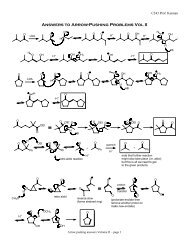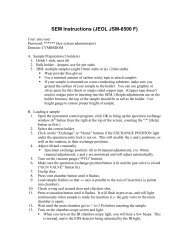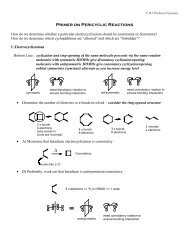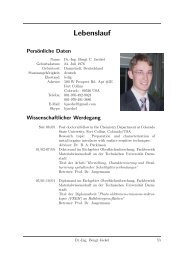Monolayer Behavior of NBD-Labeled Phospholipids at the Air/Water ...
Monolayer Behavior of NBD-Labeled Phospholipids at the Air/Water ...
Monolayer Behavior of NBD-Labeled Phospholipids at the Air/Water ...
- No tags were found...
Create successful ePaper yourself
Turn your PDF publications into a flip-book with our unique Google optimized e-Paper software.
5542 Langmuir, Vol. 18, No. 14, 2002 Tsukanova et al.<br />
Figure 3. Typical epifluorescence micrographs for a DPPE-<strong>NBD</strong> monolayer in <strong>the</strong> expanded region (A) and in <strong>the</strong> pl<strong>at</strong>eau (B) <strong>of</strong><br />
<strong>the</strong> π-A iso<strong>the</strong>rm. Micrograph B was taken <strong>at</strong> A ) 0.55 nm 2 /molecule and π ) 8 mN/m. The scale bars are 40 µm.<br />
Figure 4. Typical epifluorescence micrographs for an <strong>NBD</strong>(C 12)-PC monolayer in <strong>the</strong> 1.5-0.82 nm 2 /molecule region (A) and <strong>at</strong><br />
areas below 0.82 nm 2 /molecule (B). Micrograph B was taken <strong>at</strong> A ) 0.5 nm 2 /molecule and π ) 33 mN/m. The scale bars are as in<br />
Figure 3.<br />
fluorescent domains in a low-intensity fluorescent background<br />
were typical <strong>of</strong> <strong>the</strong> micrographs taken <strong>at</strong> areas<br />
below 0.82 nm 2 /molecule. As compression proceeded,<br />
domains <strong>of</strong> both kinds grew slightly larger in size.<br />
The observ<strong>at</strong>ion <strong>of</strong> domains in <strong>the</strong> micrographs <strong>of</strong> an<br />
LE-type monolayer such as th<strong>at</strong> <strong>of</strong> <strong>NBD</strong>(C 12 )-PC (see<br />
iso<strong>the</strong>rm b, Figure 2), which is presumed to exhibit a single<br />
homogeneous phase up to <strong>the</strong> point <strong>of</strong> monolayer collapse,<br />
is unexpected. However, even more striking is <strong>the</strong> fact<br />
th<strong>at</strong> replacement <strong>of</strong> one aliph<strong>at</strong>ic chain in DPPC by an<br />
<strong>NBD</strong>-labeled chain changes <strong>the</strong> organiz<strong>at</strong>ion <strong>of</strong> DPPC <strong>at</strong><br />
<strong>the</strong> air/w<strong>at</strong>er interface in a way th<strong>at</strong> effectively prevents<br />
phosph<strong>at</strong>idylcholine molecules from <strong>the</strong>ir well-recognized<br />
form<strong>at</strong>ion <strong>of</strong> ferroelectric domains. 12,34 Thus, it is clear<br />
th<strong>at</strong> <strong>the</strong> unique morphology observed for <strong>the</strong> <strong>NBD</strong>(C 12 )-<br />
PC monolayer as well as <strong>the</strong> form<strong>at</strong>ion <strong>of</strong> a hex<strong>at</strong>ic phase<br />
in <strong>the</strong> DPPE-<strong>NBD</strong> monolayer should be considered in<br />
terms <strong>of</strong> localiz<strong>at</strong>ion <strong>of</strong> <strong>NBD</strong> chromophores <strong>at</strong> <strong>the</strong> interface<br />
and <strong>the</strong>ir interactions with each o<strong>the</strong>r and with <strong>the</strong><br />
headgroups <strong>of</strong> phospholipid molecules as discussed below.<br />
3.2. Surface Potential-Area (∆V-A) Iso<strong>the</strong>rms<br />
and Localiz<strong>at</strong>ion <strong>of</strong> <strong>the</strong> <strong>NBD</strong> Chromophore <strong>at</strong> <strong>the</strong><br />
<strong>Air</strong>/W<strong>at</strong>er Interface. Since <strong>the</strong> iso<strong>the</strong>rms <strong>of</strong> both <strong>NBD</strong>labeled<br />
phospholipids reach almost <strong>the</strong> same areas per<br />
molecule near monolayer collapse as those <strong>of</strong> <strong>the</strong> parent<br />
phospholipids, <strong>the</strong> <strong>NBD</strong> group might be assumed to be<br />
ei<strong>the</strong>r buried bene<strong>at</strong>h <strong>the</strong> DPPE-<strong>NBD</strong> headgroup or<br />
(34) Bowen, P. J.; Lewis, T. J. Thin Solid Films 1983, 99, 157.<br />
elev<strong>at</strong>ed on top <strong>of</strong> <strong>the</strong> <strong>NBD</strong>(C 12 )-PC monolayer to achieve<br />
monolayer packing densities similar to those <strong>of</strong> <strong>the</strong> parent<br />
phospholipids lacking <strong>NBD</strong>. To assess in a first approxim<strong>at</strong>ion<br />
<strong>the</strong> orient<strong>at</strong>ion <strong>of</strong> <strong>the</strong> <strong>NBD</strong> moiety <strong>at</strong> <strong>the</strong><br />
interface, surface potential measurements were performed.<br />
The ∆V-A iso<strong>the</strong>rms <strong>of</strong> <strong>the</strong> <strong>NBD</strong>-phospholipid<br />
and parent phospholipid monolayers <strong>at</strong> <strong>the</strong> air/w<strong>at</strong>er<br />
interface are presented in Figure 5A. Iso<strong>the</strong>rms <strong>of</strong> <strong>the</strong><br />
DPPC and DPPE monolayers are similar to those reported<br />
elsewhere, 28,29,35 and thus, <strong>the</strong>y are not discussed fur<strong>the</strong>r,<br />
but used for comparison. At large areas per molecule, <strong>the</strong><br />
surface potential <strong>of</strong> <strong>the</strong> <strong>NBD</strong>(C 12 )-PC monolayer was<br />
always positive. As seen in Figure 5A, after <strong>the</strong> jump, <strong>the</strong><br />
surface potential rises smoothly and reaches a value <strong>of</strong><br />
+287 mV <strong>at</strong> an area <strong>of</strong> 0.48 nm 2 /molecule, slightly larger<br />
than <strong>the</strong> collapse area <strong>of</strong> <strong>the</strong> π-A iso<strong>the</strong>rm. In contrast,<br />
<strong>the</strong> DPPE-<strong>NBD</strong> monolayer exhibits vari<strong>at</strong>ions <strong>of</strong> surface<br />
potential during compression. No jump in <strong>the</strong> surface<br />
potential is observed on lift-<strong>of</strong>f. The onset <strong>of</strong> <strong>the</strong> surface<br />
potential is r<strong>at</strong>her difficult to determine, but can be loc<strong>at</strong>ed<br />
anywhere between 1.5 and 1.3 nm 2 /molecule. Then, <strong>at</strong> an<br />
area <strong>of</strong> approxim<strong>at</strong>ely 1.1 nm 2 /molecule, <strong>the</strong> surface<br />
potential starts to decrease progressively until a minimum<br />
value <strong>of</strong> -81 mV is <strong>at</strong>tained <strong>at</strong> <strong>the</strong> beginning <strong>of</strong> <strong>the</strong> pl<strong>at</strong>eau<br />
in <strong>the</strong> π-A iso<strong>the</strong>rm. Upon fur<strong>the</strong>r compression, ano<strong>the</strong>r<br />
slope change occurs in <strong>the</strong> ∆V-A iso<strong>the</strong>rm <strong>at</strong> an area <strong>of</strong><br />
0.83 nm 2 /molecule from which ∆V increases rapidly,<br />
(35) Hayashi, M.; Muram<strong>at</strong>su, T.; Hara, I. Biochim. Biophys. Acta<br />
1972, 255, 98.











